

by Cameron Macht and Anthony Schaffhauser
September 2018
Medical and clinical lab technicians and technologists may not be as well known among health professions, but they also save lives – and in Minnesota job prospects are growing.
In taking a blood test, most people quickly get to know their phlebotomist, nurse and doctor, but they rarely get to meet the expert technicians and technologists who actually conduct the scientific analysis to provide the test results. The behind-the-scenes nature of the work in medical and diagnostic laboratories conceals the opportunities of this essential and rapidly growing subsector of the health care industry as well as the impending labor force needs, creating a unique challenge to growing the pipeline of future workers. This article highlights medical and clinical laboratory career fields and examines emerging trends and potential solutions to meet the workforce need. While we highlight factors that could increase the supply of workers or slow the demand growth in this field, it is clear that the industry will need proactive strategies to meet future workforce needs.
According to the official occupational description, medical and clinical laboratory technicians "perform routine medical laboratory tests for the diagnosis, treatment and prevention of disease," and "may work under the supervision of a medical technologist." Technicians typically require an associate degree for entry, and need knowledge of biology, chemistry, mathematics, and customer and personal service, in addition to technology skills in medical software and database management.1
Likewise, technologists "perform complex medical laboratory tests for diagnosis, treatment and prevention of disease," but may also "train or supervise staff." These positions require a bachelor's degree, as well as several years of work-related experience and on-the-job training. Technologists need many of the same skills and knowledge as technicians, but also need higher level skills in analysis, decision-making, critical reasoning and problem-solving.2
Despite operating behind the scenes, these are vital occupations in the health care system. As this article will demonstrate, medical laboratory technicians and technologists are in high demand due to rapid growth and are projected to stay that way in the future, and though they require higher education, they also earn higher wages. Put simply, laboratory work offers a great opportunity for growth.
Most medical and diagnostic laboratory work is performed at hospitals and offices of physicians, but a distinct North American Industry Classification System (NAICS) code shows how quickly the subsector is expanding. Employment at medical and diagnostic laboratories in Minnesota more than doubled since 2000, expanding 121.7 percent. Through 2017, there were 125 establishments providing an average of 3,751 jobs, with 3,371 of those jobs at medical laboratories and 380 jobs at diagnostic imaging centers (Table 1 and Figure 1).
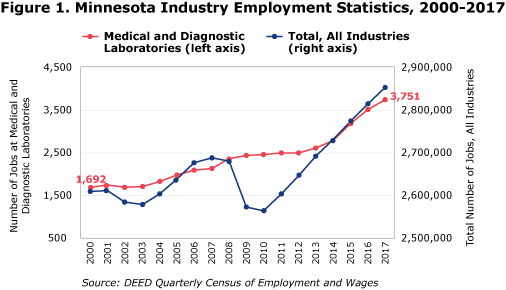
| Table 1. Minnesota Industry Employment Statistics, 2017 | ||||||||
|---|---|---|---|---|---|---|---|---|
| NAICS Code | NAICS Industry Title | Number of Firms | Number of Jobs | Average Annual Wages | Change in Jobs, 2016-2017 | Change in Jobs, 2012-2017 | ||
| Numeric | Percent | Numeric | Percent | |||||
| 0 | Total, All Industries | 167,573 | 2,853,313 | $56,160 | 39,391 | 1.4% | 208,378 | 7.9% |
| 6215 | Medical and Diagnostic Laboratories | 125 | 3,751 | $66,976 | 237 | 6.7% | 1,254 | 50.2% |
| 621511 | Medical Laboratories | 90 | 3,371 | $66,508 | 233 | 7.4% | 1,277 | 61.0% |
| 621512 | Diagnostic Imaging Centers | 35 | 380 | $71,188 | 4 | 1.10% | -23 | -5.70% |
| Source: DEED Quarterly Census of Employment and Wages | ||||||||
In fact, medical and diagnostic laboratories were the second fastest growing health care and social assistance subsector in the state from 2012 to 2017, trailing only other residential care facilities, but outpacing other fast growing areas like home health care services, offices of other health care practitioners, and continuing care retirement communities and assisted living facilities.
With all of this growth, we asked an audience of medical and clinical laboratory professionals at their annual conference to assess how dire the workforce shortage is becoming. The overwhelming consensus (62 percent of respondents) was that it's moderate – they're going to need some help to fill their jobs – but not at a critical stage yet. Less than half as many respondents (26 percent) reported that it's serious. They don't know how they're going to fill their open jobs. The final 12 percent said that it wasn't bad at all. They feel like they should be able to find the people they need.
Participants agreed that the workforce shortage is much more challenging in rural areas and more difficult to manage for smaller operations. Providers in rural areas reported a smaller pool of potential candidates to choose from, and fewer educational opportunities to train new workers. Likewise, representatives from smaller laboratories mentioned that the smaller number of workers who can train new employees makes it more complicated to bring entry-level technicians in and get them up to speed quickly.
There are also some differences in what technicians and technologists are asked to do based on the setting of the laboratory. Participants explained that technicians tend to handle a wider variety of tasks in rural settings; whereas technicians and technologists working at larger laboratories tend to be more specialized, focusing on very specific responsibilities. The larger laboratories in the Twin Cities metro area and Southeast Minnesota also tend to do more complex testing that requires technologists, rather than technicians, to perform.
Over the past five years, employers have reported an average of over 230 vacancies for medical laboratory positions, with a notable increase in the past two years. There was a combined average of more than 300 vacancies in 2017, the highest number since a spike in demand was reported in 2005 (Figure 2).
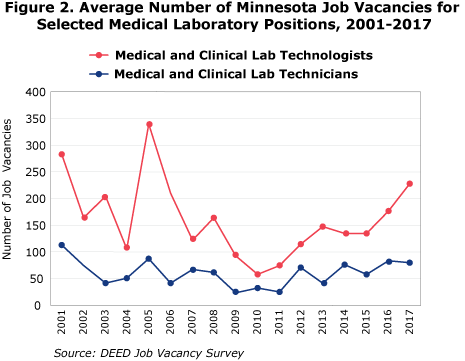
As noted, while rural areas tend to rely more on technicians, the Twin Cities and Southeast regions show more demand for technologists. In sum, demand had been relatively evenly split across the state over the past five years, until the majority of vacancies shifted back to the metro area in 2017 (Figure 3).
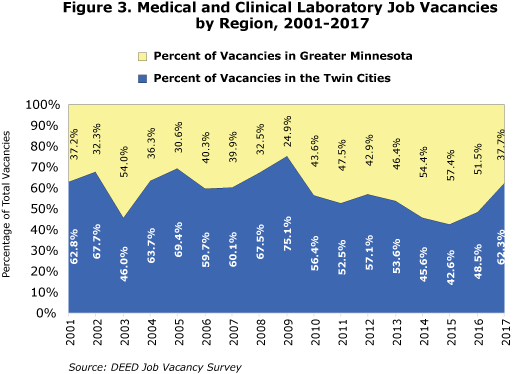
Wages for technicians and technologists range between $40,000 and $80,000 per year, and have also been increasing in recent years. Despite the relatively high wages, respondents at the conference felt like they haven't been keeping up with other similar health care positions, such as registered nurses or x-ray technicians. In the most recent Job Vacancy Survey, the median wage offer for medical laboratory technicians was $17.56 per hour, compared to $18.33 for radiologic (x-ray) technicians, $19.21 for MRI technologists, $19.27 for surgical technologists, $19.56 for licensed practical nurses, and $24.01 for dental hygienists, all of which also require an associate degree. The median hourly wage offer for medical laboratory technologists was $23.23, compared to $30.23 for registered nurses, and one can work as an RN with an associate degree, whereas a bachelor's degree is required for medical laboratory technologists.
Beyond that, the perception is that, long-term, wages also might not keep pace with other health care occupations, making laboratory positions less attractive in addition to being less visible. While technicians and technologists earn above average salaries, wage percentiles from DEED's Occupational Employment Statistics program appear to verify that a gap exists – median wages for technicians were lower than many of the comparison occupations, and the top end 90th percentile wages were also lower (Table 2).
| Table 2. Employment and Wages for Selected Health Care Occupations in Minnesota, 2018 | ||||||
|---|---|---|---|---|---|---|
| Occupational Title | Employment | Hourly Wage Percentiles | ||||
| 10th | 25th | Median | 75th | 90th | ||
| Medical Laboratory Technologists and Technicians | 7,880 | $18.05 | $21.44 | $26.66 | $33.08 | $38.56 |
| Registered Nurses | 64,540 | $26.26 | $30.94 | $37.67 | $44.77 | $49.19 |
| Magnetic Resonance Imaging (MRI) Technologists | 600 | $31.75 | $33.60 | $36.63 | $39.74 | $45.80 |
| Dental Hygienists | 5,090 | $27.46 | $31.71 | $35.27 | $38.86 | $44.88 |
| Radiologic Technicians and Technologists | 4,750 | $22.72 | $26.56 | $31.11 | $36.50 | $40.08 |
| Surgical Technologists | 2,150 | $20.58 | $23.25 | $26.80 | $30.13 | $34.58 |
| Licensed Practical and Licensed Vocational Nurses | 16,840 | $17.06 | $19.65 | $22.04 | $24.40 | $27.96 |
| Source: DEED Occupational Employment Statistics, 2018 | ||||||
Demand appears to be strong for medical and clinical laboratory positions in the future as well. DEED's Employment Outlook program projects nearly 850 new jobs for technicians and technologists over the next decade, growing about twice as fast as the total of all occupations. In addition, there may be as many as 250 openings each year due to exits and transfers. Rather than new jobs being created, these are existing jobs that will become available as the workers who currently hold them retire out of the labor force or change jobs (Table 3).
| Table 3. Minnesota Employment Projections, 2016-2026 | |||||||
|---|---|---|---|---|---|---|---|
| Occupational Title | 2016 Employment Estimate | 2026 Employment Projection | 2016-2026 Numeric Change | 2016-2026 Percent Change | 2016-2026 Annual Exits | 2016-2026 Annual Transfers | 2016-2026 Annual Total Openings |
| Total, All Occupations | 3,097,300 | 3,278,900 | 181,600 | 5.90% | 148,028 | 195,076 | 361,264 |
| Medical Laboratory Technologists | 4,234 | 4,694 | 460 | 10.90% | 135 | 135 | 316 |
| Medical Laboratory Technicians | 3,616 | 4,004 | 388 | 10.70% | 115 | 115 | 269 |
| Source: DEED 2016-2026 Employment Outlook | |||||||
Demographic data show that the average age of workers at medical and diagnostic laboratories has increased. Just 20 years ago, almost two-thirds (65.5 percent) of the workforce was between 25 and 44 years of age. Now just half (50.4 percent) is in that age group. Instead, 22 percent of the workforce is now 55 years and older, up from about 10 percent in 1997. The number of jobs in the 45 to 54 year old age group also increased rapidly, from 16.3 percent of the workforce in 1997 to 22.7 percent in 2017 (Figure 4).
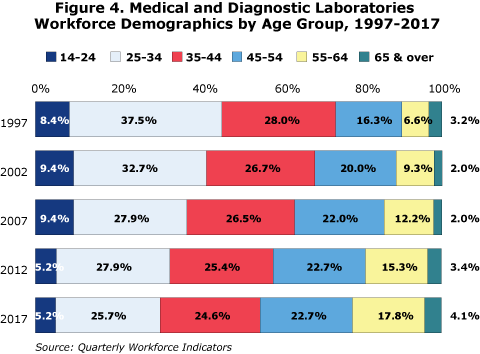
And while the industry might like to hire more young people, the education and training requirements for laboratory workers make it difficult to hire inexperienced or untrained workers. The demographic data show that less than 1 percent of the workforce is 21 years or younger, and just 4.3 percent is between 22 and 24 years of age. That puts it at a disadvantage in comparison to all other industries, especially the other rapidly growing health care subsectors that can hire high school students and get them into the pipeline quicker. For example, almost one-fourth (22.9 percent) of the workforce at continuing care retirement communities and assisted living facilities was 24 years and younger, indicating a much stronger feeder system.
While the data show that laboratories are relying more on older workers, the professionals in the field don't believe that increased labor force participation rates for older workers are a great solution for the impending workforce shortage. Instead, human resources managers believe existing medical laboratory technicians and technologists are getting ready to retire, and will do so when they are able. Some of the older workers who said they would like to stay on the job stated that they would need their employers to be flexible, either in hours or responsibilities. And they also remarked that changes in the field are so great and so swift that it would be hard to jump back into the workforce after a period away without extensive training.
The medical and diagnostic laboratories workforce has also become more diverse over time, although diversity seems to have reached a peak in the early 2000s. As Figure 5 shows, the share of minority workers in the industry was highest during the 2003 to 2007 period and has decreased since then.
The demographic data show that the subsector has a slightly higher reliance on Asian or Other Pacific Islanders, but a lower concentration of black or African American workers and workers of Hispanic or Latino origin. Though workers of races other than white hold 12 percent of jobs, they accounted for almost 16 percent of the new jobs added in the subsector since 1997 (Figure 5).
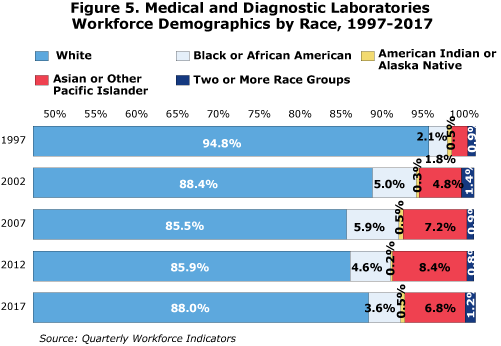
Industry professionals suggested that immigration is a small but potentially viable source of new workers. Anecdotally, hiring managers say there is very little overseas outsourcing currently being done, but they cited an example of a rural location in South Dakota that was bringing in workers from the Philippines for six-month stays to fill the laboratory roles. In that case, they stated that the foreign workers were already trained in their home country and were able to work in the U.S. once they arrived. To that end, the HR managers noted that there is a challenge in matching up the existing education of foreign workers with the requirements in the U.S., making it a less attractive solution.
In response to tight labor markets, some employers are seeking ways to maximize the work that medical laboratory technicians and technologists are doing, either by modifying job responsibilities or creating new roles that take on a portion of the laboratory work. Professionals reported that there are already some lower-level tasks that have been taken on by CMAs, CNAs and phlebotomists, which have been received positively by those working in the field. Respondents were less enthusiastic about RNs being asked to take on some of the laboratory work. To be clear, the idea isn't to replace medical laboratory technologists or technicians, but to see if there are areas or job responsibilities that could be handled by lower-skilled workers, which would free up time to meet demand. It is worth noting that some states are adopting this tactic even more than Minnesota. For example, in states that license medical laboratory professions, there is a lab assistant level of practice.
Currently practicing medical and clinical laboratory technicians and technologists at the conference agreed that the biggest change in the job moving forward is going to be automation, and many say that it is already happening. While technological advancements are making laboratory work more efficient, they also lead to an expanding array of new and more advanced medical tests. Even with automation, this increases the demand. Industry experts also believe that there are a lot of unnecessary tests that could potentially be scaled back, which would help free up time for the more important work that the laboratory does. The medical field has been working to reduce this so-called "inappropriate laboratory utilization," and that is good for patients,3 but it is unlikely to stifle the demand for medical laboratory professionals.
Despite the challenge of hiring younger workers due to education and training requirements, almost 80 percent of survey respondents feel that the best workforce pipeline to tap into is high school – and even middle school – students. Of course, many other industries are also attempting to attract younger workers by increasing awareness and reaching out to high schools, so it may be more difficult for laboratories to stand out in such a crowded field. Respondents also saw a benefit in reaching out to a more diverse group of job seekers, though they believe that can also be accomplished by working more closely with schools where student populations are more diverse than their own workforce.
One significant challenge that providers in rural locations face is the lack of post-secondary training options. It was noted that most rural areas have access to two-year community and technical colleges, which can train technicians, but they do not have access to the four-year universities that train technologists. Because of that, both awareness and the educational attainment of the regional workforce in rural areas are low.
Anecdotally, several respondents pointed out that many people don't discover laboratory careers until they are older – often in their late 20s and early 30s, rather than their teenage years. The feeling was that this delay makes obtaining the necessary education more challenging, especially for people with families.
In addition, conference participants said medical laboratory college programs are very tough, causing many students to drop out during the process. Because of that, it was suggested that instead of scholarships, employers might get more bang for their buck by offering paid internships and loan payback plans. These options would be more attractive for potential candidates in these young to middle-age groups.
What Does it Take to Achieve a Medical Laboratory Career?Both of the occupations featured require higher education and, usually, certification. Medical laboratory technicians must complete a two-year Medical Laboratory Technology or Medical Laboratory Technician (MLT) degree, while medical laboratory technologists complete a Clinical Laboratory Science or Medical Laboratory Science (MLS) bachelor's degree. Given the scientific rigor of these higher education programs, prospective MLT and MLS students should take science and math courses in high school, including biology, chemistry and physics, plus at least three years of math. Those who enter these career paths should have an interest in science and mathematics. They should also possess a drive for accuracy, attention to detail, and the ability to multitask, as well as professional integrity and a desire to contribute to quality health care. Another characteristic of people in these professions is a preference to spend most of their time in a laboratory rather than in direct contact with patients and their families. According to industry experts, an associate degree is required to work in medical clinical laboratories as an MLT. Eleven Minnesota colleges offer this degree. These programs are accredited and approved by the National Accrediting Agency for Clinical Laboratory Sciences (NAACLS). The courses are heavy in science and include practical laboratory and clinical instruction. Like most health care programs, there are specific entry requirements, including background checks and immunizations, as well as academic requirements for courses and grades. Some have competitive admissions where the highest ranked applicants are accepted. Program completers are eligible to take the Board of Certification exam of the American Society for Clinical Pathology (ASCP). Passing this exam bestows the Medical Laboratory Technician ASCP Board Certification. Hiring practices in Minnesota generally require this certification. Most MLT programs publicize their completers' ASCP Board pass rates, and many of these programs have agreements in place with four-year Medical Laboratory Science programs for students to continue their education. The Medical and Clinical Laboratory Technologist occupation is commonly referred to as Medical Laboratory Scientist (MLS), also the title of the Board Certification. Seven Minnesota universities offer a bachelor's MLS program. These programs combine a strong foundation in science and math with the liberal arts required for bachelor's degrees, and clinical experience depending on the program. Be aware that even though this is a bachelor's degree, it may take more than four years to complete depending on what program you attend. Another option is a post-degree program: The Mayo Clinic College of Medicine, for example, offers a 10 month program for graduates of a university chemistry or human biological sciences bachelor's degree program. What the additional two to three years of school gets you, besides higher pay, is more opportunity to use logic and science to analyze, troubleshoot and solve problems to enable doctors to diagnose and treat patients. In addition, an MLS will often gain staff training or supervisory responsibilities. Go to My Next Move for career profiles and training programs in your area, and be sure to check NAAICS for program accreditation. |
Industry professionals still felt that increasing awareness and changing perceptions would be the most helpful recruitment strategy. As noted above, one huge barrier is that most people know what nurses are and what x-ray technicians do, but many people don't know anything about laboratory workers because they don't see or interact with them. To overcome that, medical laboratory workers have been participating in Scrubs Camps and other outreach activities with schools.
Other rapidly growing health care subsectors are hiring lots of front-line workers like home health aides, personal care aides and certified nursing assistants that require little educational preparation, while nursing remains one of the most popular training programs in the state. Operating behind the scenes, medical and clinical laboratory technicians and technologists occupy a health care niche that requires significant educational preparation, but also provides great opportunities. More lab workers will be needed in the future to meet the growing demand, so awareness will be key in a tight labor market.
We have shown the rapid growth in the medical and diagnostic laboratory industry, as well as the strong demand for medical laboratory technicians and technologists recently and projected into the future. We also discuss measures or countertrends that might counteract or help meet future needs. Professionals in the industry inform us that automation, changing technician and technologist job roles to focus on the higher-level tasks, as well as elimination of unnecessary tests are all important to increase efficiency in their field. Furthermore, one can imagine that having lower-level tasks performed by other workers might allow younger, less educated workers to enter the laboratory worker pipeline. The overall potential of increasing efficiency may be one reason why the majority of professionals we asked view the worker shortage as moderate rather than serious.
However, unlike for the broader labor market, these professionals do not believe retaining older workers past traditional retirement age will be a significant countertrend. Likewise, outsourcing, immigration and tapping into a high school-age pipeline will not have the same effect on the medical laboratory industry as other industries due to the higher education and certification requirements. Perhaps most significantly, the behind-the-scenes nature of medical laboratory work poses a challenge to raising awareness of these career opportunities. With the growth in diversity of the medical and diagnosing laboratories subsector showing signs of plateauing, the need to raise awareness and interest among a broader population emerges as an important focus for industry and education collaboration.
1Summary Report for: 29-2012.00 - Medical and Clinical Laboratory Technicians. O*NET Online.
2Summary Report for: 29-2011.00 - Medical and Clinical Laboratory Technologists. O*NET Online.
3McDonald, Emily et al. Mindfulness-Based Laboratory Reduction. The American Journal of Medicine (2017) 130, e241-e244.